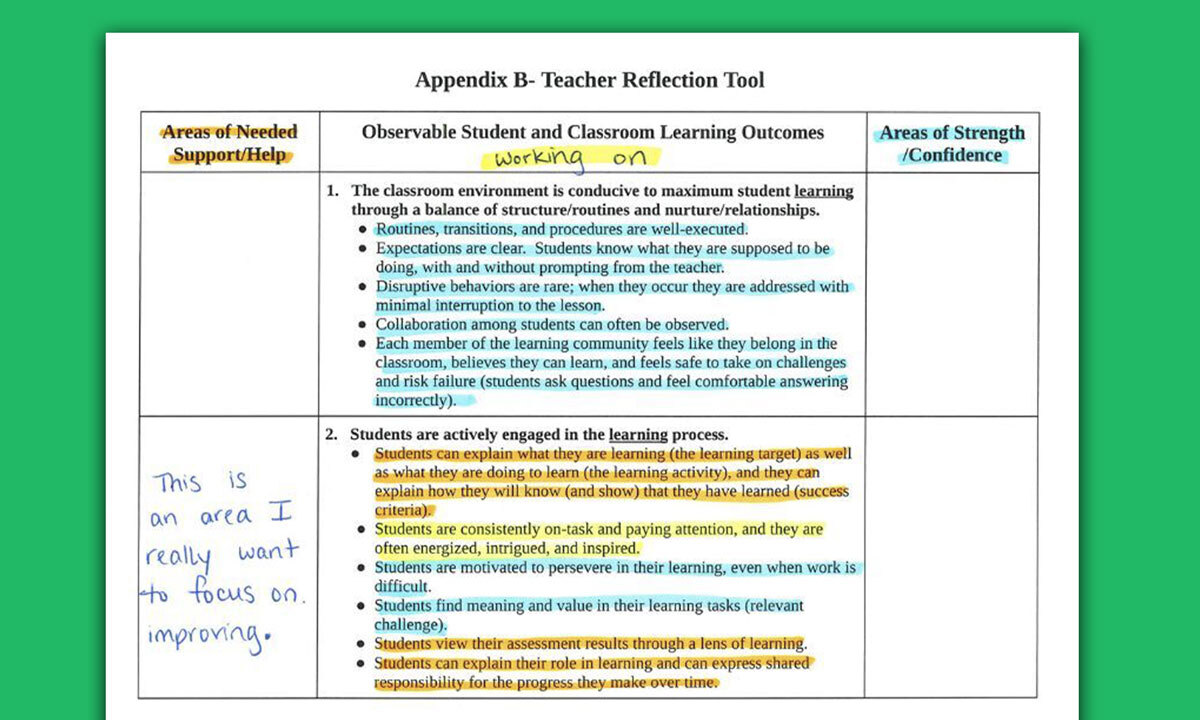How My District Is Rethinking Evaluations to Help Teachers Grow and Improve
Superintendent's view: By emphasizing teachers’ confidence in their abilities, we created an environment that fosters professional development.

Get stories like this delivered straight to your inbox. Sign up for The 74 Newsletter
When done right, yearly performance evaluations can be a powerful tool for professional growth. Reviews are a time when staff members can celebrate their achievements, identify and develop their key strengths, and receive objective insights to close skill gaps.
Most teacher evaluations, however, are just another check box on an administrator’s to-do list and a lesson in futility for those on both sides of the table. State reforms have tied success to high-stakes standardized test scores and other rigorous quantitative measures, which one study found have “no detectable effect on student achievement or attainment.”
As school leaders reimagine education, they have focused intensely on student growth. But they must also — and perhaps first — rethink how to help educators grow and improve. Prioritizing teachers’ professional development is crucial. Educators need support and guidance to enhance their practice and benefit student learning. Too often, administrators point out issues and wash their hands of the problem, expecting teachers to construct their way out without any support.
At Eastern Hancock Schools, where I serve as superintendent, we unearthed some uncomfortable truths about the traditional evaluation processes. Teachers reported that evaluations induce anxiety, often lack accuracy and fail to facilitate professional growth. Administrators found the system burdensome, obstructing genuine conversations focused on improvement.
This isn’t merely an implementation issue; it’s symptomatic of a flawed system on both the macro level and in one-on-one implementation that needs to be fixed — not just here in small-town Indiana, but also in school districts nationwide.
When speaking with my fellow superintendents, district administrators and, most importantly, teachers, flaws that devalue what should be an empowering process emerged:
- Unrealistic expectations placed on evaluators’ expertise. Twenty years ago, I student-taught kindergarten. However, this doesn’t qualify me to offer nuanced guidance to current kindergarten teachers. An overreliance on evaluators’ instructional and content expertise is a critical defect, leading to evaluations that are subject to criticism from those who work in classrooms every day.
- Averaging scores from multiple classroom visits. This approach shifts the focus from the qualitative aspects of teaching to a quantitative score, which can be misleading and distracts from meaningful, constructive feedback. Once scores are assigned, they tend to overshadow the actual practices and areas for improvement that led to them. Teachers preoccupied with a high rating may neglect valuable insights and constructive criticism that could help them strengthen their practice. This score-centric approach creates a stressful and competitive environment, detracting from what should be a collaborative and developmental evaluation process.
- Limiting observations to rubric-based evaluations. Performance metrics are often prioritized over teachers’ abilities, turning “observations from tools of learning into tools of judgment.” Scores are often inflated because administrators may feel unqualified or insecure about giving lower scores and fear a backlash. Conversely, some administrators suggest that achieving the highest standards outlined in rubrics is nearly impossible, discouraging the pursuit of excellence. Both scenarios undermine the integrity and effectiveness of the evaluation.
- Lack of mentorship for teachers. There’s a common misconception that administrators cannot simultaneously serve as evaluators and coaches. On the contrary, our primary responsibility should be to facilitate educators’ professional improvement and foster a culture of continuous growth.
To truly reform evaluations, administrators must shift from a system of judgment to one centered on teacher improvement. At Eastern Hancock, we began reimagining our approach in fall 2022 and continued refining it throughout the school year through meetings with teachers and administrators. We began implementing the Teacher Growth Plan in fall 2023, placing educators at the heart of the process and empowering them to own their professional growth.
Most teacher evaluation systems start with an administrator rating a teacher’s performance during classroom observations, then awarding grades ranging from 1 to 4 and averaging those scores. Those marks are entered in a four-column rubric, ranking the teacher’s performance for various criteria as “not good at all,” “needs improvement,” “good enough” or “best.”
This gives educators limited opportunities to share their experiences and provide input into their growth and feedback. We wanted to change that. Instead of relying primarily on administrators judging a series of classroom visits, we give each teacher a three-column rubric that focuses exclusively on best practices in different areas, such as classroom environment and student engagement. These are listed in the middle column, while the left and right columns are blank. The left column is headed “areas of needed help/support,” while the right side is headed “areas of strength/confidence.” The teachers use this rubric to reflect on their practices and assess their confidence in meeting these standards, and then fill in the blanks with their thoughts. On the left, they note areas for growth, and on the right, their strengths. This sets a framework for vital and honest conversations with the evaluator, focused on creating a plan for individual development.
This self-assessment forms the basis for setting goals in five focus areas: an orderly and relationship-focused classroom; clarity around what students will learn (not just what they do); a deep understanding of students to anticipate their varying needs; ability to create engaging learning activities; and reflective and responsive instructional practices.
Teachers meet with evaluators throughout the year to discuss their progress. Unlike traditional models, points are earned through the teacher’s willingness and ability to reflect, set goals and demonstrate improvement. Classroom observations are conducted frequently, sparking meaningful conversations and allowing exemplary practices to be shared and learned from. Ongoing discussions help monitor progress, and midyear conferences provide updates on goals and plans — particularly for teachers who are new to the district or at risk of low performance ratings.
At the end of the year, teachers and evaluators sit down to talk about progress on goals set for the year. The teachers present updated self-assessments and final reflections. Then, together with the evaluators, they use collected evidence and professional judgment to complete the evaluation. Those meeting proficiency criteria can step into leadership roles, contribute to professional development and peer mentorship, earn additional points and become eligible for a highly effective rating.
The evaluation process is transparent, supportive and aligned with the district’s mission of continuous improvement and exceptional educational outcomes, ensuring that teachers can actively engage in their personal growth.
Both teachers and administrators have responded positively. During meetings with evaluators, teachers reported increased confidence and a stronger focus on their improvement goals compared to prior years. Administrators say the new system makes it easier to engage in meaningful, growth-oriented conversations with teachers.
By prioritizing improvement and emphasizing teachers’ confidence in their abilities, we have created a more effective environment that fosters professional development and career growth for our educators. Most traditional teacher evaluation systems neglect the role of educators in addressing their own progress. This new approach allows administrators to support teacher growth, leading to a more collaborative and supportive environment for educators, ultimately resulting in better outcomes for students.
Get stories like these delivered straight to your inbox. Sign up for The 74 Newsletter

;)
